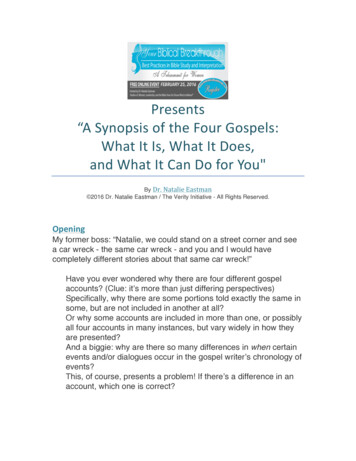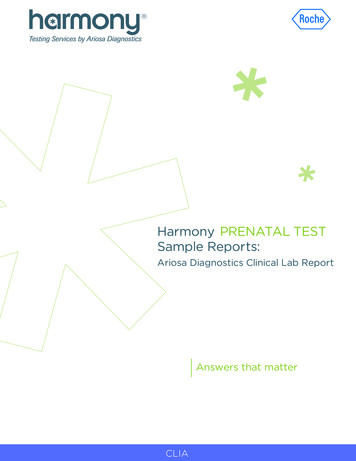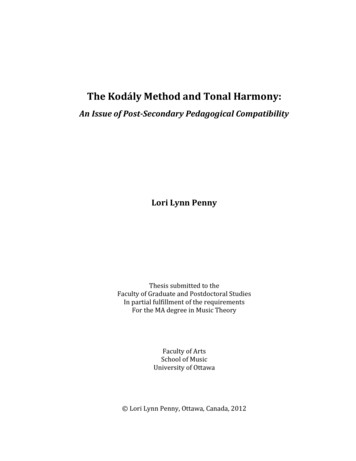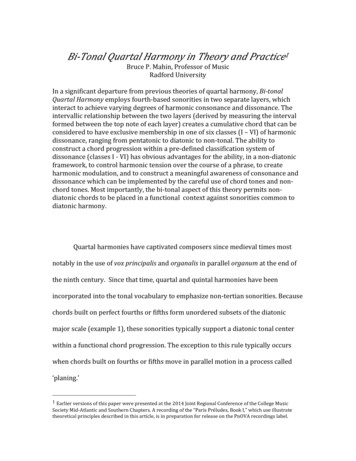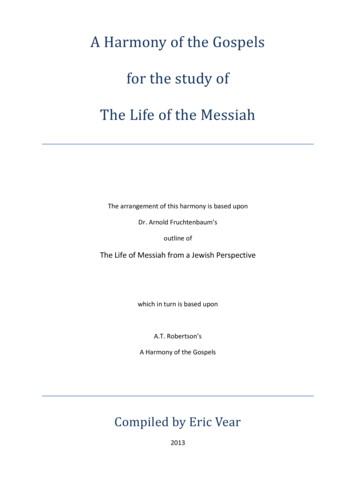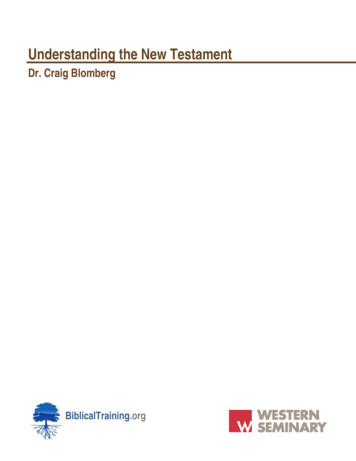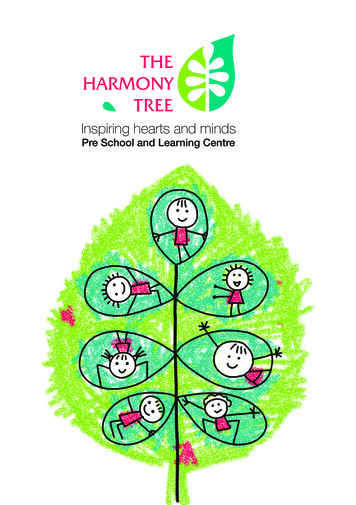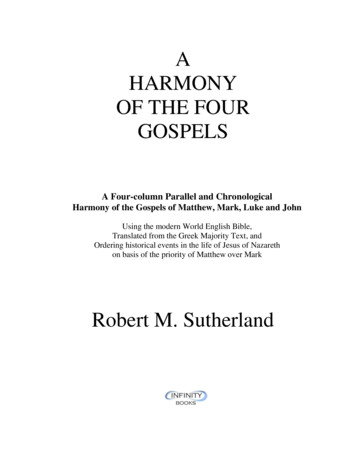
Transcription
AHARMONYOF THE FOURGOSPELSA Four-column Parallel and ChronologicalHarmony of the Gospels of Matthew, Mark, Luke and JohnUsing the modern World English Bible,Translated from the Greek Majority Text, andOrdering historical events in the life of Jesus of Nazarethon basis of the priority of Matthew over MarkRobert M. Sutherland
Published byInfinity Books LtdMaltaDistributed Worldwide through AmazonPublished un-exclusively by kind permission of Mr. Robert M. SutherlandCopyright Robert M. SutherlandAll rights reservedISBN 9798648813656―World English Bible‖ (WEB), 2005, un-copyrighted. Used with thanks.We acknowledge Mr. Sutherland‘s statement on the freely distributed pdf filesupplied to us for this edition, which states, ―This publication, in whole or part, maybe reproduced, stored in a retrieval system, or transmitted, in any form or by anymeans, electronic, mechanical, photocopying, recording, or otherwise, without thewritten prior permission of the author, but with an acknowledgment of this author‘sauthorship of whatever material is used. I seek no royalities, but if a book publisherwished to reduce this work to a hard copy form for others, they can charge such profitfor their work as they deem appropriate for their work. They just need to know inadvance that all other publishers have that same right. And the PDF and Wordformatted copies of this book remain available free of charge to all on the internet.‖May God bless this project.
This book is dedicated to my wifeCindy Sutherland.
TABLE OF CONTENTSPREFACE to Infinity‘s printed editionINTRODUCTION1. The basic question to be asked and answered0142. This book‘s introductory nature143. This book‘s author154. This book‘s use of the World English Bible165. This book‘s use of the Greek Majority Text176. This book‘s use of the Priority of Matthew over Mark237. Helpful methodologies for the reader278. A proper methodology for understanding truth279. A proper methodology for understanding the natural moral law3610. A proper methodology for understanding historical inquiry4011. An improper methodology for understanding historical inquiry59A CHRONOLOGICAL PRESENTATION OF THE GOSPEL EVIDENCE1. Authorial introductions(Matthew 1:1; Mark 1:1; Luke 1:1-4; John 1:1-18)712. Jesus‘ genealogy(Matthew 1:2-17; Luke 3:23-38)733. The angel‘s revelation to Zechariah and his response(Luke 1:5-25)754. The angel‘s revelation to Mary and her response(Luke 1:26-56)755. The angel‘s revelation to Joseph and his response(Matthew 1:18-25)766. The birth of John the Baptist and Zechariah‘s response(Luke 1:57-80)777. Caesar‘s census and the birth of Jesus
(Luke 2:1-7)788. The angel‘s revelation to the Bethlehem shepherds and their discovery of Jesus(Luke 2:8-20)789. Jesus‘ circumcision in the Temple and his discovery by Simeon and Anna(Luke 2:21-39)7910. Wise men journey from the east and their discovery of Jesus(Matthew 2:1-12)8011. Joseph, Mary and Jesus flee into Egypt(Matthew 2:13-23)8012. Jesus‘ early life in Nazareth(Luke 2:39-40)8113. Jesus‘ trip to Jerusalem at age 12(Luke 2:41-51)8114. Jesus‘ early life in Nazareth continued(Luke 2:52)8215. John the Baptist baptizes Jesus(Matthew 3:1-17; Mark 1:2-11; Luke 3:1-22; John 1:6-14,19-34)8216. Jesus meets his future disciples: Andrew, John, Philip, Nathanael(John 1:35-51)9017. Jesus and friends go to a wedding in Cana(John 2:1-11)9118. Jesus goes to Capernaum with family and friends(John 2:12)9119. Jesus is tempted by the devil in the wilderness(Matthew 4:1-11; Mark 1:12-13; Luke 4:1-13)9120. Jesus cleanses the Temple for the first time(John 2:13-25)9321. Jesus meets with Nicodemus the Pharisee that night(John 2:23-3:21)9622. Jesus instructs his disciples and they baptize(John 3:22-36)97
23. John is arrested and Jesus leave for Galilee(Mt 4:12; Mk 1:14; Lk 4:14; Jn 4:1-3)9824. Jesus meets the Samaritan woman at the well(John 4:4-42)9825. Jesus arrives in Galilee(Matthew 4:12-17; Mark 1:14-15; Luke 4:14-15; John 4:43-45)9926. Jesus heals a royal official‘s son(John 4:46-54)10027. Jesus calls Simon, Andrew, James and John a second time(Matthew 4:18-22; Mark 1:16-20; Luke 5:1-11)10128. Jesus delivers a Capernaum sermon(Mark 1:21-28; Luke 4:31-37)10229. Jesus delivers the Sermon on the Mount(Mathew 4:23-7:29)10330. Jesus heals a leper(Matthew 8:1-4; Mark 1:40-45; Luke 5:12-16)10731. Jesus heals a centurion‘s servant(Matthew 8:5-13; Luke 7:1-10)10832. Jesus raises the son of the widow of Nain from the dead(Luke 7:11-17)10933. Jesus heals Peter‘s mother-in-law and others(Matthew 8:14-17; Mark 1:29-34; Luke 4:38-44)10934. Jesus crosses the Sea of Galilee, and calms sea(Matthew 8:18-27; Mark 4:35-41; Luke 8:22-26)11035. Jesus heals two Gergesene/Gadarene demoniacs and their response(Matthew 8:28-9:1; Mark 5:1-20; Luke 8:26-39)11136. Jesus heals a paralyzed man on a bed and forgives sin(Matthew 9:1-8; Mark 2:1-12; Luke 5:17-26)11437. Jesus meets his future disciple Matthew and dines with sinners(Matthew 9:9-17; Mark 2:13-22; Luke 5:27-39)11538. Jesus raises Jairus‘s daughter from the dead(Matthew 9:18-26; Mark 5:22-43; Luke 8:40-56)117
39. Jesus heals two blind menMatthew 9:27-31)12040. Jesus heals a mute demoniac(Matthew 9:32-34)12041. Jesus does a Galilean tour(Matthew 9:35-38)12042. Jesus chooses 12 disciples for a Jewish ministry(Mt 10:1-42; Mk 3:13-19; 6:6-13; Luke 6:12-16; 8:1-3; 9:1-6)12043. Jesus delivers the Sermon on the Plain(Luke 6:17-49)12844. John the Baptist, through disciples, questions Jesus about his ministry(Matthew 11:1-30; Luke 7:18-35)12945. Jesus dines at the house of Simon the Pharisee(Luke 7:36-50)13246. Jesus‘ disciples pluck grain on the sabbath(Matthew 12:1-8; Mark 2:23-28; Luke 6:1-5)13247. Jesus heals a man with a withered hand on the sabbath(Matthew 12:9-21; Mark 3:1-12; Luke 6:6-11)13348. Jesus heals a blind mute demoniac(Matthew 12:22-50; Mark 3:19-35)13549. Jesus delivers a series of parables on the kingdom of heaven(Matthew 13:1-53; Mark 4:1-34; Luke 8:4-21)13750. Jesus heals and invalid at the pool of Bethesda on a sabbath(John 5:1-47)14451. Jesus delivers a sermon in Nazareth(Matthew 13:54-58; Mark 6:1-6; Luke 4:16-30)14652. Herod Antipas's interest in Jesus as John the Baptist returned from the dead(Matthew 14:1-12; Mark 6:14-29; Luke 9:7-9)14853. Jesus feeds 5000 and the crowds attempt to make him king(Matthew 14:13-23; Mark 6:30-44; Luke 9:10-17; John 6:1-15)15054. Jesus crosses the Sea of Galilee by walking on water
(Mt 14:24-33; Mk 6:47-52; Jn 6:16-21)15355. Jesus heals the sick in Gennesaret(Matthew 14:34-36; Mark 6:53-56)15556. Jesus delivers the Bread of Life sermon in Capernaum(John 6:22-7:1)15557. Jesus declares the oral and oral ceremonial law obsolete(Matthew 15:1-20; Mark 7:1-23)15758. Jesus heals the demoniac child of a Syrophoenician woman(Matthew 15:21-28; Mark 7:24-30)15959. Jesus heals the mute, deaf, lame and blind in Decapolis(Matthew 15:29-31; Mark 7:31-37)16060. Jesus feeds 4000(Matthew 15:32-38; Mark 8:1-9)16061.Jesus talks about the sign of Jonah and the leaven of the Pharisees(Matthew 15:39-16:12; Mark 8:10-21; John 7:1)16162. Jesus heals a blind man(Mark 8:22-26)16363. Peter confesses Jesus to be the Messiah(Matthew 16:13-20; Mark 8:27-30: Luke 9:18-21)16364. Jesus predicts his death in Jerusalem for the first time(Matthew 16:21-28: Mark 8:30-9:1: Luke 9:22-27)16465. Jesus is transfigured(Matthew 17:1-13; Mark 9:2-13; Lk 9:28-36)16566. Jesus heals an epileptic demoniac child(Matthew 17:14-21; Mark 9:14-29; Luke 9:37-43)16767. Jesus predicts his death in Jerusalem for a second time(Matthew 17:21-23; Mark 9:30-32; Luke 9:43-45)16968. Jesus pays the temple tax(Matthew 17:24-27)17069. The disciples‘ dispute over who is the greatest in the kingdom of heaven(Matthew 18:1-22; Mark 9:33-50; Luke 9:46-50)170
70. Jesus contemplates going to Jerusalem for Tabernacles, leaves Galilee(John 7:1-13)17571. Jesus at the Feast of Tabernacles: the political controversy(John 7:14-36)17672. Jesus at the Feast of Tabernacles: the water controversy(John 7:37-58)17773. Jesus at the Feast of Tabernacles: the woman caught in adultery(John 7:59-8:11)17774. Jesus at the Feast of Tabernacles: the light of the world controversy(John 8:12-59)17875. Jesus at the Feast of Tabernacles: the man born blind from birth controversy(John 9:1-10:6)18076. Jesus at the Feast of Dedication(John 10:7-42)18277. Jesus begins his final journey to Jerusalem(Matthew 19:1; Mark 10:1; Luke 9:51-52)18378. Jesus in Samaria and reprimands James and John, the sons of thunder(Luke 9:51-62)18379. Jesus picks 70 disciples for a Samaritan ministry(Luke 10:1-24)18480. Jesus and the parable of the Good Samaritan(Luke 10:25-37)18581. Jesus visits with Mary and Martha(Luke 10:38-42)18582. Jesus teaches on the power of prayer(Luke 11:1-13)18683. Jesus exorcises a demoniac and is challenged(Luke 11:14-36)18784. Jesus dines with a Pharisee(Luke 11:37-54)18885. Jesus teaches about blasphemy against the Spirit(Luke 12:1-12)188
86. Jesus delivers a series of parables(Luke 12:13-13:9)18987. Jesus heals a crippled woman on the Sabbath(Luke 13:10-17)19188. Jesus delivers a further series of parables(Luke 13:18-21)19189. Jesus speaks of the narrow gate to heaven(Luke 13:22-30)19190. Jesus is warned about Herod Antipas and laments over Jerusalem(Luke 13:31-35)19291. Jesus a man with dropsy on the Sabbath(Luke 14:1-6)19292. Jesus delivers a further series of parables(Luke 14:7-17:10)19393. Jesus heals 10 lepers(Luke 17:11-19)19694. Jesus speaks of the coming of the Son of Man(Luke 17:20-37)19795. Jesus delivers a further series of parables(Luke 18:1-14)19796. Jesus speaks on marriage, divorce, celibacy and blesses children(Matthew 19:3-15; Mark 10:2-16; Luke 18:15-17)19897. Jesus encounters a rich ruler(Matthew 19:16-30; Mark 10:17-31; Luke 18:18-30)20098. Jesus delivers the parable of labourers in the vineyard(Matthew 20:1-16)20299. Jesus raises Lazarus from the dead(John 11:1-57)203100. Jesus predicts his death in Jerusalem a third time(Matthew 20:17-19; Mark 10:32-34; Luke 18:31-34)205101. James and John vie for positions in the kingdom of heaven
(Matthew 20:20-28; Mark 10:35-45)206102. Jesus heals a blind man Bartimaus(Matthew 20:29-34; Mark 10:46-52; Luke 18:35-43)206103. Jesus meets a future disciple Zacchaeus(Luke 19:1-10)207104. Jesus delivers the parable of the 10 servants(Luke 19:11-28)208105. Jesus is anointed the first time(John 12:1-11)209106. Jesus enters Jerusalem triumphantly(Mt 21:1-11; Mk 11:1-11; Lk 19:29-44; Jn 12:12-19)209107. Greeks come to Jesus through Philip(John 12:20-50)214108. Jesus cleanses the temple a second time(Matthew 21:12-27; Mark 11:12-19; Luke 19:45-48)215109. Jesus delivers the parable of the fig tree(Matthew 21:18-22; Mark 11:12-14, 20-26)216110. Jesus comments on his authority and relationship to John the Baptist(Matthew 21:23-27; Mk 11:27-33; Lk 20:1-8)217111. Jesus delivers the parable of the 2 sons(Matthew 21:28-32)218112. Jesus delivers the parable of the vineyard(Matthew 21:33-46; Mark 12:1-12; Luke 20:9-19)218113. Jesus delivers the parable of the banquet(Matthew 22:1-14)220114. Jesus comments on the payment of taxes to Caesar(Matthew 22:15-22; Mark 12:13-17; Luke 20:20-26)221115. Jesus comments on the afterlife(Matthew 22:23-33; Mark 12:18-27; Luke 20:27-40)222116. Jesus comments on the greatest commandment(Matthew 22:34-40; Mark 12:28-34)223
117. Jesus comments on David‘s son and David‘s lord(Matthew 22:41:46; Mark 12:35-37; Luke 20:41-44)224118. Jesus condemns the Pharisees(Matthew 23:1-39; Mark 12:38-40; Luke 20:45-47)225119. Jesus comments on the widow‘s mite(Mark 12:41-44; Luke 21:1-4)229120. Jesus delivers the Olivet discourse to his disciples(Matthew 24:1-25:30; Mark 13:1-37; Luke 21:5-38)229121. Jesus's opponents finalize their plot to kill(Matthew 26:1-5,14-16; Mark 14:1-2,10-11; Luke 22:1-6)239122. Jesus is anointed a second time(Matthew 26:6-13; Mark 14:3-9)240123. Jesus celebrates the Last Supper(Matthew 26:17-35; Mark 14:12-31; Luke 22:7-38; John 13:1-17:26)242124. Jesus is arrested in the Garden of Gethsemene(Matthew 26:36-56; Mark 14:32-52; Luke 22:39-53; John 18:1-12)268125. Jesus' Jewish trial before Caiaphas(Matthew 26:57-27:2; Mark 14:53-15:1; Luke 22:54-71; John 18:13-26)273126. Judas commits suicide(Mt 27:3-10)279127. Jesus' Roman trial before Pilate(Matthew 27:11-31; Mark 15:1-20; Luke 23:1-25; John 18:28-19:18)279128. Jesus is executed by crucifixion(Matthew 27:31-56; Mark 15:21-41; Luke 23:26-49; John 19:18-30)289129. Jesus is buried(Matthew 27:57-66; Mark 15:42-47; Luke 23:50-56; John 19:31-42)297130. Various women, Peter, John at the empty tomb and Jesus appears(Mt 28:1-15; Mk 16:9-11; Luke 24:1-12; John 20:1-18)300131. Jesus appears to 2 disciples on the road to Emmaus(Mark 16:12-13; Luke 24:13-35)306132. Jesus appears to the disciples in Jerusalem absent Thomas(Mark 16:14-18; Luke 24:33-49; John 20:19-23)308
133. Jesus appears to the disciples in Jerusalem with Thomas(John 20:24-30)310134. Jesus appears to the disciples in Galilee(John 21:1-25)311135. Jesus appears and delivers the great commission(Matthew 28:16-20; Mk 16:15-18)312136. Jesus appears and ascends to heaven(Mark 16:19-20; Luke 24:50-53; Acts 1:9-12)313A BIBLIOGRAPHY315
14INTRODUCTION1. THE BASIC QUESTION TO BE ASKED AND ANSWEREDThe biblical gospels of Matthew, Mark, Luke and John tell the greatest story ever told. Thesecond divine person of the triune God of love came to earth in the person of Jesus of Nazareth todemonstrate the height, breadth and depth of the love of God, and to offer and effect a personaltransformation in and through that love, in this life and the next life, for all who would trust inand and surrender to him.These four biblical gospels of Matthew, Mark, Luke and John assert three things. (1) Jesusof Nazareth claimed to be divine. (2) He died for that claim. (3) He rose again from the dead toestablish the truth of that claim. These are purely historical matters, knowable and provable on abalance of probabilities in the court of public opinion.2. THIS BOOK’S INTRODUCTORY NATUREThis book is as an introductory interpretive aid, to all students of all ages, interested inknowing for themselves something of the objective historical truth of those claims and theirbiblical foundation.I say introductory for at least three reasons.First, this book is simply how I would format the testimonial evidence of the various gospelwriters as a first step to an examination as to their individual and collective credibility and reliability,and the reader will likely find it helpful. This book does not indicate why certain other evidence isnecessarily excluded on the grounds of irrelevance and immateriality. This book does not contain myassessment of the evidence in terms of analysis of the credibility and reliability of certain events andtheir authors, which would include material beyond the testimonial accounts themselves. This bookdoes not contain my judgements in the areas of the totality of the evidence, the strength of theevidence, and the sufficiency of the evidence in meeting the historical standard of proof on a balanceof probabilities. Those three things are the subject of a later book.Second, a philosophical check is a necessary and reflective check on any historicalconclusions reached, and this book does not provide that. History is in the realm of the possible:what is said to have happened in the past. Philosophy sets out the range of the possible, what canhappen: past, present or future. While philosophy can be a handmaiden to theology, it is equallytrue that philosophy is a traffic cop to history. If any one of these five things: (1) the existence ofGod, (2) the Trinity, (3) the Incarnation, (4) the Resurrection or (5) the Final Judgement islogically impossible, then any historical claim that Jesus rose from the dead in fulfillment of atruth claim to be divine is necessarily false, regardless of how good the historical evidence is inits favour. Suffice to say at this point, I find that, on that evidence, that the existence of God, theTrinity, the Incarnation, the Resurrection and the Final Judgment is either logically probable ornecessary, and thus, any historical claim that Jesus rose from the dead in fulfillment of a truthclaim to be divine as might be found in historical testimony of the gospel writers is corroboratedphilosophically. That evidence in those five areas is the subject of a later book.
15Third, knowledge is but a pre-ample to faith. The knowledge might be afforded byhistorical inquiry certainly commends itself to the mind for acceptance as truth, at least until suchtime as further evidence or better ways of weighing the evidence become available. Butknowledge is not faith. It is said in the scriptures themselves that the devils themselves know thehistorical truth of things, but remain damned. Why? Because they have not taken the second stepfrom knowledge to faith. Knowledge is an intellectual act. Faith is a certain type of volitional act,a personal choice and commitment, sometimes based on knowledge, sometimes not. As arelational concept, faith is always expressed as the oneness of three things: gratitude for,surrender to and love of a particular person. The gospel writers of Matthew, Mark, Luke and Johnpresent the knowledge of Jesus of Nazareth that they do, for the purpose of enjoining theirreaders to make a personal and passionate commitment to him. (1) They enjoin a faith in Jesusthat is a personal gratitude to Jesus for what he has done for you, especially on the cross, and willdo for you personally, especially in this life and at the time of the Final Judgment. (2) Theyenjoin a faith in Jesus that is a personal surrender to Jesus as your rightful lord and saviour herein this life. (3) They enjoin a faith in Jesus that is an on-going personal transformation by the loveof God in and through Jesus actually living in you. Faith is different from knowledge, as any actof the will is different from any act of the intellect. But faith is related to the knowledge of thetruth. A faith in Jesus is only a saving faith, if two things are historically and philosophically true.(1) Jesus is who he claimed to be: God incarnate, and (2) Jesus can and will do what he claimedhe will do: grant eternal salvation to all who trust in him and only him.In that respect, the knowledge provided in this book may be helpful for readers, eitherprompting a personal choice in faith to invite Jesus into your life or reinforcing a choice alreadymade.3. THIS BOOK’S AUTHORI suspect the reader will want to know who I am.First, I am a Canadian defence lawyer with 34 years at the bar. I hold a four-year HonoursB.A. in the History of Ideas from University of Toronto (1977-1981). I hold a three-year L.L.B.in Law from Osgoode Hall Law School (1981). My law school criminal law and criminalprocedure professor was Louise Arbour, who would later become a Supreme Court of Canadajustice, sit on the World Court in the Hague and is currently the United Nations Human Rightscommissioner. I have practised criminal law, child protection law and family law for 34 years infive provinces: Ontario (1986-2005), Alberta (2005-2007), Newfoundland-Labrador (20072010), Nova Scotia (2010-2017), Manitoba (2017-2018), Nova Scotia (2018-2020). In the courseof my career, I have some notable successes, changing the law nationally and provincially atvarious points in time. Throughout my career, my legal work has been focused on therepresentation of the poor and those otherwise in dire need of help.Second, I am a philosophically moderate realist and a natural law thinker, in the traditionof the three great Western thinkers: Aristotle, Thomas Aquinas and Moritmer J. Adler. The last ofththe three was one of my mentors. Mortimer J. Adler was a prominent 20 century Americanphilosopher of common sense, a former law school professor from the University of Chicago, thehead of the Institute for Philosophical Research, and for many decades the Chairman of the Boardof Editors of the Encyclopedia Britannica, responsible for its publication of the 62 volume Great
16Books (1952, expanded 1992) series. I first discovered his writings in 1988, was quickly transformedby them, joining his American Chicago-based think-tank the Mortimer J. Adler Center for the Studyof the Great Ideas (http://www.thegreatideas.org), serving as its Canadian director for a number ofyears, having communications with Dr. Adler through its director Max Weismann. I would stronglyrecommend to the readers seven of Mortimer J. Adler‘s books: How to Read a Book (1972), How toThink About the Great Ideas (2000), Six Great Ideas (1997) Ten Philosophical Mistakes (1997), WeHold These Truths (1987), Truth in Religion (1990), and How to Think About the Great Ideas (2000)and four of Dr. Edward Feser‘s books: Aquinas: A Beginner’s Guide (2009), Philosophy of Mind(2006), Five Proofs of the Existence of God (2017), Aristotle’s Revenge: The MetaphyicalFoundations of Physical and Biological Science (2019) for their own philosophical check on thoseany historical claims and conclusions arising from the gospels themselves.Third, I am an evangelical Christian, theologically traditional, in most areas, but Baptist in myrejection of the doctrine of original sin and its inherited transmission of damnation. I was not raisedChristian and had no childhood religious upbringing. In my high school years (1972-1977), I readvirtually all the writings of an English Calvinist poet John Milton, a Scottish Presbyterian theologianWilliam Barclay, a German philosopher Friedrich Nietzsche, and an Austrian pyscho-analyst EricFromm, and those readings were preparatory to my ultimate religious conversion. I trace my spiritualjourney back to a powerful ―born-again‖ experience on August 20, 1976. I was aged 18 years old,alone in a tent in middle of the backwoods of Prince Edward Island. I had just finished listening to aChristian sharing his testimony to others around a campfire outside my tent. He was not reachingthem, but he was reaching me. He never knew it, and he never knew I was there. I have alwaysregarded it as a profound reminder that you never know the influence you can have on others. In1981, I was simultaneously accepted into the ―Wycliffe‖ seminary at the Toronto School of Theologyand the Osgoode Law School. I choose the law school over the seminary. And it was not a choice Ihave ever regretted. My legal training and career have afforded me the time, talent and treasure topursue my religious interests in the direction and depth that I wanted. In 2004, I published a bookPutting God on Trial: The Biblical Book of Job, a revolutionary contribution to Job studies that hasbeen a course text in several Canadian, American and Indian universities. Over the years, I have beenblessed with many blessings. The most important blessing is my closest friend and selfless wifeCindy Sutherland, whom I cherish beyond life itself. My hope and prayer is that the reader would findsuch a companion as she on their journey. In the meantime, the spiritual blessings that I canrecommend to readers include any of Dr. Malcolm Guite‘s ―You-Tube‖ videos on Love, Light,Coleridge, Lewis and Tolkien and Dr. Charles Mathewes‘ two audiobooks ―City of God‖ and ―WhyEvil Exists‖, the latter being a profoundly deep examination of the meaning of good and evil inWestern civilization through its very best thinkers, religious and otherwise, from 4500 BC to thepresent day. Everywhere should wrestle with the questions that book raises and with the range ofoptions it offers. I currently fellowship in and am a member at my local church down the street, a partof United Church of Canada.4. THIS BOOK’S USE OF THE WORLD ENGLISH BIBLEI have used the World English Bible (WEB) for this work, with some of its notes in brackets.First, I would note the World English Bible (WEB) is a modern translation in the King JamesVersion (KJV) tradition: elegant, readable and fairly literal. It is actually an evangelical revision ofthe 1901 American Standard Version (ASV), which itself was a kind of KJV update. I have
17chosen it over the KJV or ASV, because the language is more modern. No translation can ever be orshould be completely literal, for simple reason that it would cease to be a translation. And yet, thereare real advantages in aiming, as this translation does, at a formal rather than a dynamic equivalencein the translation of Hebrew or Greek into English. The reader does not have to believe in theinerrancy of the scriptures in order to read the texts closely, attentive to what is actually said.Second, I would note that the World English Bible (WEB) has the decisive advantage ofbeing free from all copyright and attendant royalties. Virtually all modern English translations arecopyrighted. If I were to use any popular modern translation, then my reproducing all fourgospels in parallel columns for analysis would be virtually impossible financially. The owner ofthe copyright to those modern translations would normally require an up-front royalty of at least 10,000 and on-going royalties of at least 10 for each individual sale. I choose to make thiswork affordable and available to all free of charge.THIS BOOK’S USE OF THE GREEK MAJORITY TEXTI note that the World English Bible (WEB) is translated from the Greek Majority Text(MT), which some might think a problem, but I do not.First, all New Testament (NT) translations necessarily build on some particular reconstructedGreek text.(1) The original autographs do not survive.(2) Out of the 5865 ancient manuscripts or fragments of the Greek NT that do, no twodocuments agree 100% with each other. The printing press would not be invented until 1454 AD.(3) For the approximate 138,000-142,000 Greek New Testament words, depending on thereconstructed Greek text chosen for the NT, there are about 500,000 variant readings, thoughthey do seem to divide into families of textual variants, where a family is defined as its memberssharing, at least 60% of the time, common textual readings for a passage.(4) A textual variant or textual reading is any place in the text where there is a difference in languagefrom a base text. You might call it an error or a corruption, but you need not. It is just a difference.Those differences can be simple differences in spelling (as there was no standardized ancient spellingof a word), in word order (as there was no standardized ancient grammar and there were various waysto convey a single thought with no loss in meaning), or in additions or omissions of words (sometimesaccidental, sometimes intentional). This is what generates the high number of 500,000 textual variants.(5) What is important is not the number of textual variants, but their nature or kind. About 99.5% arenot meaningful or viable. They don‘t change the meaning even in a slight way. They are so late or rarein the manuscript stream that they could not possibly represent the original reading. About 0.5% aremeaningful and viable. They do change the meaning, sometimes slightly, sometimes more so. They areviable in that they could possibly represent the original reading. That reduces the 500,000 textualvariants down to about 2,000 textual variants, for the New Testament as a whole, only a portion ofwhich is in the gospels, that might be worth discussing, but they all are resolvable. My resolution ofthat portion of the 2000 textual variants dealing with the four gospels is the subject of a later book.
18Second, textual criticism is the method of historical inquiry by which textual variants areresolved. The basic principle is ―one should choose the reading that best explains the rise of theothers.‖ It begins, using a base text, with an assessment of credibility (believability) asking: whatwas an original author likely to have written, and what was a scribe likely to have written, inorder to arrive at a plausible story as to what happened in textual transmission.(1) To sort out the New Testament variations, the King James Version (KJV) basically uses therdReceived Text (RT): essentially Erasmus‘ 1522 reconstructed Greek text (3 edition) as amended bythStephanus‘ 1589-1590 reconstructed Greek text (5 edition). The editors of the Received Test basedththeir work on only 7 Byzantine Greek manuscripts, none earlier than the 11 century A.D., thoughththey had access to the rival Catholic Complutensian Polygot which referenced the 4 centuryAlexandrian manuscript Vaticanus, but they rejected it and its tradition as an inaccuraterepresentation of the Greek original. The same editors had extensive knowledge of the early Churchndfathers‘ quotations of New Testament readings going back to the 2 century A.D. It is kind of aregional variation on the Majority Text (MT), not using best and most representative Greek textswithin that tradition, which were then not known to it. The resulting Revised Text (RT) is about142,000 Greek words in length; that is to say, about 2000 Greek more than the Majority Text (MT)and about 4000 Greek words more than the Nestle Aland-United Bible Societies Text (NU).(2) To sort out the New Testament variations, the World English Bible (WEB) basically uses the1885 Majority Text (MT), as amended by Robinson and Pierpont‘ 1991 and 2005 reconstructedGreek text. The editors of the Majority Text base their work on about 1000 or so completethByzantine Greek manuscripts, none early than the 5 century AD. The same editors hadextensive knowledge of the early Church fathers‘ quotations of New Testament readings goingback to the second century A.D. The resulting Majority Text contains about 140,000 Greekwords; that is to say, about 2000 Greek words less than the Revised Text (RT) and about 2000Greek words more than the Nestle Aland-United Bible Societies Text (NU). The Majority Text(MT) and the Revised Text (RT) agree on the readings about 98.5 % of the time.(3) To sort out the New Testament variations
Harmony of the Gospels of Matthew, Mark, Luke and John Using the modern World English Bible, . And the PDF and Word formatted copies of this book remain available free of charge to all on the internet.‖ May God bless this project. This book is dedicated to my wife


